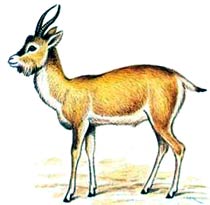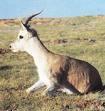Save The Zeren
Posted by: Loren Coleman on May 15th, 2008

What’s a “zeren”? Of course, if you are a frequent visitor to Cryptomundo, you know what the Yeren is, to wit, the population of so-called “Wild People” or unidentified hairy hominoids of China. But what is the zeren?

The zeren, discovered first in 1777, is the strange megafauna known also as the Mongolian gazelle (Procapra gutturosa). They live on the grassy steppe and subdeserts of Mongolia, northern China, and southern Russia. Just as the pronghorn in the Americas seems an out-of-place antelope, so too does this species in Mongolia-China-Russia, and few in the West know of it.
Zerens are very speedy animals. Zerens can gallop up to 39 mph (65 kmph), and sustain this speed for 7-9 miles (12-15 kilometers), leaping up to 6.6 feet (2 meters) into the air.

This medium-sized antelope has become known as the zeren due to a Russian corruption of the Mongolian language name of zeer.

The zeren population is thought to number around 2 million, but no comprehensive count has been undertaken and this figure may be an overestimate for political reasons. Herds of 6,000-8,000 animals of both sexes are said to gather in the spring, when the northerly movements begin, covering 120-180 miles (200-300 kilometers) in a single day. Therein lies the source of trouble for the zeren, based on breaking news being reported in the Russia media:

MOSCOW, May 14 (RIA Novosti) – Thousands of Mongolian gazelles, or zerens, who have been forced north by years of drought, have died after being caught up in barbed wire lining the Russian border, a popular tabloid reported on Wednesday.
Komsomolskaya Pravda said over 20,000 zerens, a species of antelope, have managed to cross the fence on the Mongolian side but have become entangled in the three-meter-high fence on the Russian side, and have died of injuries and thirst.
The animals have been trying to reach Russia’s Daursky nature reserve just across the border, which is rich in vegetation and water.
The paper quoted the head of the nature reserve, Alexander Borodin, as saying such a vast migration from the Mongolian steppes has never been seen before.
“There are now around 100,000 zerens moving toward our border. If they all die on the neutral territory near our border, an environmental catastrophe will be unavoidable.”
On Tuesday Russia’s environmental watchdog Rosprirodnadzor asked the governor of the Chita Region to provide water for the zerens.
The paper said the Daursky nature reserve lacks the equipment and funds to transport such a large volume of water, and that even if the border is opened, most of the animals will be too weak to reach the nearest lakes.
Zerens are classified as “conservation dependent” on the International Union for the Conservation of Nature and Natural Resources’ Red List of threatened species.
About Loren Coleman
Loren Coleman is one of the world’s leading cryptozoologists, some say “the” leading living cryptozoologist. Certainly, he is acknowledged as the current living American researcher and writer who has most popularized cryptozoology in the late 20th and early 21st centuries.
Starting his fieldwork and investigations in 1960, after traveling and trekking extensively in pursuit of cryptozoological mysteries, Coleman began writing to share his experiences in 1969. An honorary member of Ivan T. Sanderson’s Society for the Investigation of the Unexplained in the 1970s, Coleman has been bestowed with similar honorary memberships of the North Idaho College Cryptozoology Club in 1983, and in subsequent years, that of the British Columbia Scientific Cryptozoology Club, CryptoSafari International, and other international organizations. He was also a Life Member and Benefactor of the International Society of Cryptozoology (now-defunct).
Loren Coleman’s daily blog, as a member of the Cryptomundo Team, served as an ongoing avenue of communication for the ever-growing body of cryptozoo news from 2005 through 2013. He returned as an infrequent contributor beginning Halloween week of 2015.
Coleman is the founder in 2003, and current director of the International Cryptozoology Museum in Portland, Maine.










A provocative article that makes you think about the consequences of fragmenting nature and about the true meaning of ‘endangered.’ Here is one relatively plentiful species that is threatened from a disruption of its lifestyle – migration to a greener pasture. This brings to memory the report that polar bears, although also plentiful, are facing starvation because they can’t find trapped seals as a result of global melting. We should begin to realize that there might be many other plentiful species out there that are seriously endangered because of a dam, highway, fence or drought. A big number in the population no longer guarantees the health of a species in our fast changing world. Thanks Loren!
As Richard888 points out, plentiful is not equal to unendangered.
Another example of a plentiful but currently endangered species? Homo sapiens
Agreed, r-p-j, but are Homo sapiens cuddly enough for us to care about?
LOL sausage, I don’t know about “cuddly”, but there are definitely some specimens that merit conservation:
http://viparena.info/salma-hayek-and-valentina-catch-a-jet-plane/
we suck and are a plague, IMO…. Dratz! the plight of the Zeer is one case and point unless the politicians over there actually act… i wish animals could sue humans